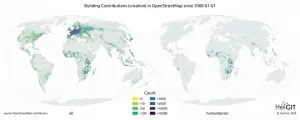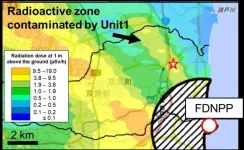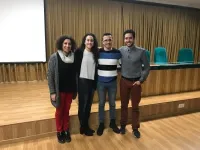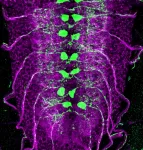New potential therapy for Crohn's disease in children
Anti-inflammatory nanotherapy produced promising results in a rodent model
2021-02-17
(Press-News.org) Scientists from the Stanley Manne Children's Research Institute at Ann & Robert H. Lurie Children's Hospital of Chicago demonstrated that a nanotherapy reduces intestinal inflammation and shrinks lesions in a rodent model of severe Crohn's disease. This approach could become an alternative to biologic antibody therapies that carry many side effects, including increased risk of certain cancers. It might also prevent the need for surgery in the future. Findings were published in the journal Advanced Therapeutics.
Crohn's disease is an inflammatory bowel disease characterized by chronic inflammation of the digestive tract, most often in the small intestine. It can lead to intestinal obstruction and perforation, bleeding, abdominal pain, severe diarrhea, fatigue, weight loss and malnutrition leading to growth abnormalities in children. One of the key features of Crohn's disease is lesions along discontinuous segments of the intestine. Current treatments include biologic antibody therapies, and in severe cases surgery, which is not curative. It is estimated that 70 percent of patients with Crohn's disease will require surgery during their lifetime and many will require additional surgery.
"We injected into the intestinal lesion nanomolecules that carry an anti-inflammatory peptide, which is a tiny portion of a protein," says senior author Arun Sharma, PhD, Director of Surgical Research at the Manne Research Institute at Lurie Children's and Research Associate Professor of Urology and Biomedical Engineering at Northwestern University Feinberg School of Medicine and McCormick School of Engineering. "The results were phenomenal. We saw reduction in inflammation based upon reductions in pro-inflammatory immune cells and proteins. The lesion size shrunk dramatically, which gives us hope that with this therapy we can salvage inflammatory tissue and avoid needing to surgically remove segments of the intestine in severe cases of Crohn's disease."
Based upon their design, these nanomolecules allow for a very concentrated dose to be introduced into a lesion. Dr. Sharma and colleagues observed that it creates an anti-inflammatory environment that not only keeps the lesion from growing but also reduces its size.
"Our study provides proof of principle findings that this nanotherapy can be effective for Crohn's disease and may be applicable to other inflammatory bowel diseases, such as ulcerative colitis," says Dr. Sharma. "Before we can translate this work to clinical application, we need to develop a less invasive mode of delivery, such as oral or via endoscopy."
INFORMATION:
This research was supported by the Hartwell Foundation.
Research at Ann & Robert H. Lurie Children's Hospital of Chicago is conducted through the Stanley Manne Children's Research Institute. The Manne Research Institute is focused on improving child health, transforming pediatric medicine and ensuring healthier futures through the relentless pursuit of knowledge. Lurie Children's is ranked as one of the nation's top children's hospitals by U.S. News & World Report. It is the pediatric training ground for Northwestern University Feinberg School of Medicine. Last year, the hospital served more than 220,000 children from 48 states and 49 countries.
ELSE PRESS RELEASES FROM THIS DATE:
2021-02-17
In response to the increase in opioid overdose deaths in the United States, many states have implemented supply-controlling and harm-reduction policy measures aimed at reducing those deaths. But a recent study from Indiana University found the policies may have had the unintended consequence of motivating those with opioid use disorders to switch to alternative illicit substances, leading to higher overdose mortality.
"Literature from public health to social sciences has presented mixed and contradictory findings on the impact of opioid policies on various opioid ...
2021-02-17
INFORMS Journal on Applied Analytics Key Takeaways:
Although waiting times in walk-up clinics are shorter, people preferred the convenience of drive-through clinics.
People believe drive-through clinics are safer, more convenient and less contagious.
You can vaccinate a large number of people without a lot of waiting and confusion using a drive-through clinic.
CATONSVILLE, MD, February 17, 2021 - Policymakers at all levels of government are racing to vaccinate hundreds of millions of people to save lives and blunt the deadly COVID-19 pandemic. New research published ...
2021-02-17
Researchers have developed a new tool for addressing disseminated intravascular coagulation (DIC) - a blood disorder that proves fatal in many patients. The technology has not yet entered clinical trials, but in vivo studies using rat models and in vitro models using blood from DIC patients highlight the tech's potential.
"DIC basically causes too much clotting and too much bleeding at the same time," says Ashley Brown, corresponding author of a paper on the work. "Small blood clots can form throughout the circulatory system, often causing organ damage. And because this taxes the body's supply of clotting factors, patients also experience excess bleeding. Depending on ...
2021-02-17
In recent years, free digital world maps like OpenStreetMap (OSM) have become a vital instrument to support humanitarian missions over the entire world. In disaster management as well as the implementation of the United Nations Sustainability Development Goals (SDGs), geodata compiled by the volunteer mapper community open up new possibilities to coordinate aid interventions and carry out sustainability projects. The mapping data are collected either locally using a smartphone and GPS device or on the basis of satellite images. An international team of researchers led by geoinformation ...
2021-02-17
The 10 year anniversary of the Fukushima Daiichi nuclear accident occurs in March. Work just published in the Journal 'Science of the Total Environment' documents new, large (> 300 micrometers), highly radioactive particles that were released from one of the damaged Fukushima reactors.
Particles containing radioactive cesium (134+137Cs) were released from the damaged reactors at the Fukushima Daiichi Nuclear Power Plant (FDNPP) during the 2011 nuclear disaster. Small (micrometer-sized) particles (known as CsMPs) were widely distributed, reaching as far as Tokyo. CsMPs have been the subject of many studies in recent years. However, it recently became apparent that larger (>300 micrometers) Cs-containing particles, with much higher levels of activity (~ 105 Bq), were also ...
2021-02-17
The brain's neural activity is irregular, changing from one moment to the next. To date, this apparent "noise" has been thought to be due to random natural variations or measurement error. However, researchers at the Max Planck Institute for Human Development have shown that this neural variability may provide a unique window into brain function. In a new Perspective article out now in the journal Neuron, the authors argue that researchers need to focus more on neural variability to fully understand how behavior emerges from the brain.
When neuroscientists investigate the brain, its activity seems to vary all the time. Sometimes activity is higher or lower, rhythmic or irregular. Whereas averaging brain activity ...
2021-02-17
The researchers analysed how Spanish children and adolescents get to school, based on studies examining the commuting patterns of 36,781 individuals over a 7-year period (2010-2017)
Researchers from the University of Granada (UGR) have conducted the most comprehensive study to date on how Spanish children and young people get to school each day, to determine the active commuting rate.
The results showed that, between 2010 and 2017, in the region of 60% of Spanish children and adolescents actively commuted to school, with no significant variations being observed during this period.
The study, which was recently ...
2021-02-17
Our brains are complicated webs of billions of neurons, constantly transmitting information across synapses, and this communication underlies our every thought and movement.
But what happens to the circuit when a neuron dies? Can other neurons around it pick up the slack to maintain the same level of function?
Indeed they can, but not all neurons have this capacity, according to new research from the University of Chicago. By studying several neuron pairs that innervate distinct muscles in a fruit fly model, researchers found that some neurons compensate for ...
2021-02-17
Scientists have used cutting-edge research in quantum computation and quantum technology to pioneer a radical new approach to determining how our Universe works at its most fundamental level.
An international team of experts, led by the University of Nottingham, have demonstrated that only quantum and not classical gravity could be used to create a certain informatic ingredient that is needed for quantum computation. Their research "Non-Gaussianity as a signature of a quantum theory of gravity" has been published today in PRX Quantum.
Dr Richard Howl led the research during his time at the University of Nottingham's School of Mathematics, he said: "For ...
2021-02-17
One early feature of reporting on the coronavirus pandemic was the perception that sub-Saharan Africa was largely being spared the skyrocketing infection and death rates that were disrupting nations around the world.
While still seemingly mild, the true toll of the novel coronavirus, SARS-CoV-2, on the countries of sub-Saharan Africa may be obscured by a tremendous variability in risk factors combined with surveillance challenges, according to a study published in the journal Nature Medicine by an international team led by Princeton University researchers and supported by Princeton's High Meadows Environmental Institute (HMEI).
"Although ...
LAST 30 PRESS RELEASES:
[Press-News.org] New potential therapy for Crohn's disease in children
Anti-inflammatory nanotherapy produced promising results in a rodent model




